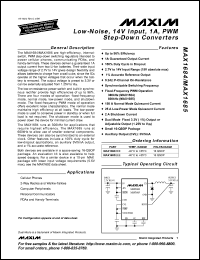|
|

|
|
| Partname: | MAX1685 |
| Description: | Low-Noise, 14V Input, 1A, PWM Step-Down Converters |
| Manufacturer: | Maxim Integrated Products |
| Datasheet: | PDF (234K).
Click here to download *) |
The MAX1684/MAX1685 are high-efficiency, internalswitch, PWM step-down switching regulators intended to power cellular phones, communicating PDAs, and handy-terminals. These devices deliver a guaranteed 1A output current from two Li-Ion batteries. Their wide input voltage range of 2.7V to 14V gives design flexibility and allows batteries to charge from a wall cube, since the ICs operate at the higher voltages that occur when the battery is removed. The output voltage is preset to 3.3V or can be externally adjusted from 1.25V to VIN. The low-on-resistance power switch and built-in synchronous rectifier provide high efficiencies of up to 96%. There are four modes of operation: fixed-frequency mode, normal mode, low-power mode, and shutdown mode. The fixed-frequency PWM mode of operation offers excellent noise characteristics. The normal mode maintains high efficiency at all loads. The low-power mode is used to conserve power in standby or when full load is not required. The shutdown mode is used to power down the device for minimal current draw. The MAX1684 runs at 300kHz for applications that require highest efficiency. The MAX1685 runs at 600kHz to allow use of smaller external components. These devices can also be synchronized to an external clock. Other features include a 100% duty cycle for low-dropout applications, an auxiliary 3V/5mA output, and a 1% accurate reference. |
|

Click here to download MAX1685 Datasheet*) |
 |
| *)Datasheets downloading from ChipDocs is only for our members (paid service). REGISTER NOW for your membership. |
|
|
|

